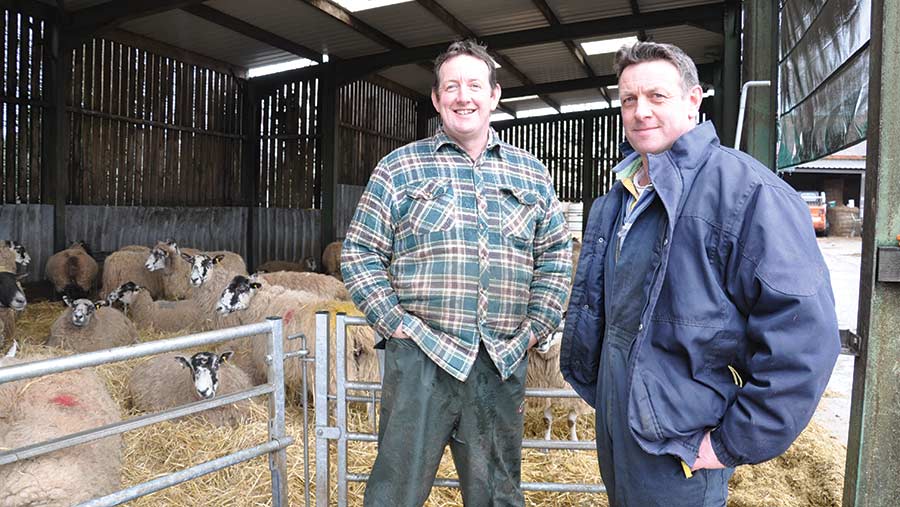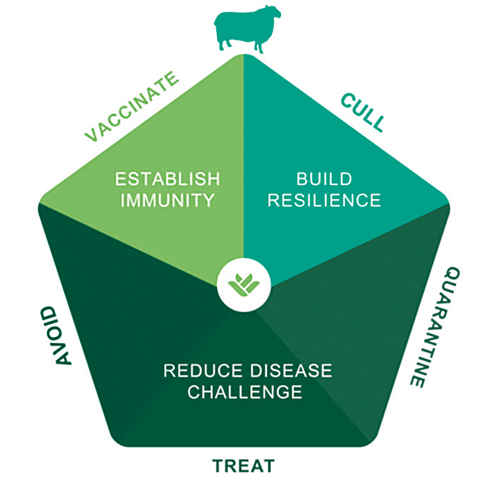How sheep farmer has reduced lameness to just 3%
 Alan (left) and Richard Fairbairn
Alan (left) and Richard Fairbairn First-generation farmer Richard Fairbairn has reduced lameness in his sheep flock from 10% to 3% by vaccinating ewes and changing his buying practices.
Mr Fairbairn, who farms in partnership with his brother, Alan, near Bromsgrove in Worcestershire, says lameness cases spiked about six years ago. He believes the trouble stemmed from buying in replacement ewes.
“We found that even though we were spending good money on yearling ewes, we were still buying in feet trouble.”
Fed up with spending precious time firefighting cases of lameness, he enlisted his vet practice, MacArthur Barstow & Gibbs, to help diagnose the problem.
See more articles on sheep lameness:
- Sheep lameness: The successes and remaining challenges
- 4 ways to reduce sheep lameness to less than 2% by 2021
- How a sheep farmer has reduced lameness by 28%
- Advice on how to vaccinate sheep against foot-rot
- Step-by-step guide to foot-bathing sheep
- Should you trim sheep’s feet to control lameness?
- Advice for quarantining incoming sheep to prevent lameness
- How sheep farmer has reduced lameness to just 3%
Treatment and culling
The vet found scald and foot-rot and advised Mr Fairbairn to administer injectable antibiotics to treat cases individually.
“It had really good results. We didn’t have too many repeat cases, so culling rates were minimal,” says Mr Fairbairn.
Farm facts
- 48ha owned, with a further 154ha rented
- 550 breeding ewes, consisting of 200 Suffolk cross North Country Mules, 250 Texel cross North Country Mules and 100 North Country Mules to produce replacements
- The Suffolks and Texels lamb from the last week of January to early March, with the North Country Mules starting in April
- 85 Simmental and Simmental cross suckler cows
- Store cattle are sold at Ludlow market
- Finished lambs are sold at Farmers Fresh, Kenilworth, and Ludlow and Worcester markets
- Horse livery
- Small contracting business
Any ewes that did go lame a second time were culled, but this was only about 3-4%.
Once they got on top of the problem, they vaccinated the whole breeding flock against foot-rot, and now vaccinate once a year only during high-risk periods.
This is normally before ewes move on to forage crops ahead of lambing, when stocking rates are high and disease risk is raised. Ewe lambs retained for breeding are vaccinated at weaning.
“That has given us the best results. Once we started using Footvax, scald dropped as well. I think it’s because it has reduced bacterial load.”
Four years ago, Mr Fairbairn also took the decision to start breeding his own replacements, so he could tighten up his flock health and lameness programme.
“I have been caught out in the past; I have bought in ewes and they brought Codd [contagious ovine digital dermatitis] on to the farm, which cost quite a bit to eradicate, so I thought that if I could breed our own replacements, it would be better all round.”
Previously, he bought in yearling ewes; now he runs a 100-head flock of North Country Mules to produce his own ewes for the terminal flock. He still has to buy in a small number of replacements for his maternal flock annually, but it has helped reduced his risk.
“I prefer to breed my own,” Mr Fairbairn says. “I always have to buy in North Country Mules, but I try to retain enough to keep up the Suffolk and Texel flocks.”
He is now more diligent when it comes to selecting replacements, too.
“I try to buy already-vaccinated sheep if I can. I would still vaccinate myself, but this gets you off on the right foot.”
He has also tightened up his quarantine procedures, so that if any lame ewes are unintentionally bought in, they don’t spread disease to the rest of the flock.
“In the past, I haven’t quarantined for long enough, but since I had the outbreak of Codd I have been more on the ball,” Mr Fairbairn says.
All bought-in yearlings are quarantined for a minimum of four weeks in a shed or field away from the other flocks.
During this time, they are put through a turnover crate and each foot is inspected for lameness and they are enrolled into the flock’s anti-abortion vaccination programme.
“If sheep have scald, we use an antibiotic spray, but if it’s anything more serious, they have injectable antibiotics. They are kept separate until they fully recover,” Mr Fairbairn says.
“We have to do the abortion vaccine first to ensure it’s done before they go to the ram, and we follow with the Footvax into the autumn.”
The brothers, who are not from a farming family, took on the tenancy at Hill Farm in 1996. They have since bought the farm and now rent a further 154ha of grassland within a five-mile radius of the holding.
Ewes and lambs are foot-bathed with disinfectant and formalin to help prevent lameness and treat scald – but with no hard concrete standing on the rented ground, it means it’s not always possible to allow feet to dry without becoming contaminated with mud.
To limit the spread of infectious foot diseases when gathering, they lime inside the handling pens and also lime high-traffics areas around water and feed troughs.
Mr Fairbairn says it’s not always practical to adhere to the FAI Five-Point Plan, but it’s about doing as much as is possible.
He says attending industry events such as Farmers Weekly’s Sheep Lameness roundtable helps focus the mind, too. “It really sharpens your pencil and ensures you carry on doing things you should be doing.”
The Five-Point Plan

Sponsor’s message

This summer, MSD Animal Health, together with Farmers Weekly, have been highlighting how the FAI Five-Point Plan (5PP) gives sheep farmers a clear framework for managing lameness effectively by bringing together recommendations from key stakeholders in the sheep farming community to provide best-practice guidance and a range of practical tips.
Adoption of the 5PP will maintain progress towards the industry target of achieving less than 2% lameness (as per FAWC 2011) in the national flock by 2021. Widespread adoption of the 5PP will also help reduce the amount of antibiotics used by the sheep industry by at least 10%, in line with the RUMA Targets Task Force 2017 recommendations.
For a healthy view of a sound flock, follow the Five-Point Plan:
- Cull to build flock resilience
- Treat, quarantine and avoid to reduce the disease challenge
- Vaccinate to establish immunity.
Further detailed advice and support is available from vet practices and SQPs in animal health trade outlets.
Thanks to MSD Animal Health, whose sponsorship made it possible to run the Sheep Lameness Roundtable 2019. Farmers Weekly had complete editorial control of this report.
